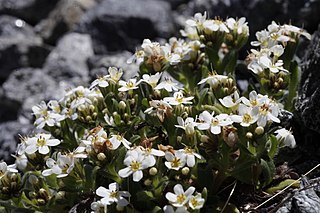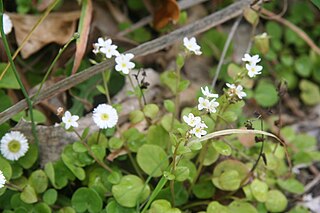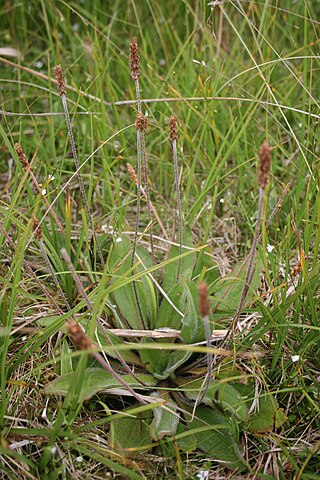
Plantago aucklandica is a species of flowering plant in the family Plantaginaceae that is endemic to the subantarctic Auckland Islands, New Zealand. Joseph Dalton Hooker described P. aucklandica in his Flora Antarctica in 1844. Plants of this plantain are large with large leaves, up to seven veins, wide petioles, colliculate seeds, and long spikes with dozens of flowers and one-seeded fruits. This species in considered to be At Risk - Naturally Uncommon, as it is an island endemic with a restricted range.

Plantago triantha is a species of flowering plant in the family Plantaginaceae that is native to Tasmania, Australia and the subantarctic Auckland Islands of New Zealand. Robert Brown described the species in 1810. Plants of this species of plantain are annual or perennial with a rosette habit, fleshy toothed leaves, and short inflorescences.

Myosotis bryonoma is a species of flowering plant in the family Boraginaceae, endemic to the South Island of New Zealand. Heidi Meudt, Jessica Prebble and Michael Thorsen described the species. Plants of this species of forget-me-not are perennial with a creeping habit, bracteate inflorescences, and white corollas.

Myosotis cheesemanii is a species of flowering plant in the family Boraginaceae, endemic to the South Island of New Zealand. Donald Petrie described the species in 1886. Plants of this species of forget-me-not are perennial rosettes with bracteate inflorescences and white corollas.

Myosotis colensoi is a species of flowering plant in the family Boraginaceae, endemic to the South Island of New Zealand. Thomas Kirk described the species in 1896. Plants of this species of forget-me-not are perennial rosettes with bracteate inflorescences and white corollas.

Myosotis spatulata is a species of flowering plant in the family Boraginaceae, endemic to New Zealand. Georg Forster described the species in 1786. Plants of this species of forget-me-not are perennial rosettes with bracteate inflorescences and white corollas.

Myosotis lyallii is a species of flowering plant in the family Boraginaceae, endemic to New Zealand. Joseph Dalton Hooker described the species in 1853. Plants of this species of forget-me-not are perennial with a prostrate habit, bracteate or partially-bracteate inflorescences, and white corollas.

Myosotis hikuwai is a species of flowering plant in the family Boraginaceae, endemic to the South Island of New Zealand. Heidi Meudt, Jessica Prebble and Geoff Rogers described M. hikuwai in 2022. Plants of this forget-me-not are spring annuals with bracteate and erect inflorescences, and small, white corollas with inserted stamens. The species is considered Threatened and known only from one population near Wānaka.

Myosotis pansa is a species of flowering plant in the family Boraginaceae, endemic to the North Island of New Zealand. Lucy Moore described the variety M. petiolata var. pansa in 1961, and it was raised to species level as M. pansa by Heidi Meudt, Jessica Prebble, Rebecca Stanley and Michael Thorsen in 2013. Plants of this species of forget-me-not are perennial rosettes with ebracteate inflorescences and white corollas and exserted anthers.

Myosotis pansa subsp. praeceps is a subspecies of flowering plant in the family Boraginaceae, endemic to the North Island of New Zealand. Lucy Moore described the variety M. petiolata var. pansa in 1961, and it was transferred to a subspecies of M. pansa by Heidi Meudt, Jessica Prebble, Rebecca Stanley and Michael Thorsen in 2013. Plants of this species of forget-me-not are perennial rosettes with partially bracteate inflorescences and white corollas with exserted stamens.

Plantago obconica is a species of flowering plant in the family Plantaginaceae that is endemic to the South Island of New Zealand. William Sykes described the species in 1988. It is the smallest Plantago species in New Zealand. Plants of this species of plantain are perennial with a rosette habit, with very narrow, linear, keeled leaves, and fruiting capsules with a 1-cm long funnel-like base.

Plantago triandra is a species of flowering plant in the family Plantaginaceae that is endemic to New Zealand. Sven Berggren described the species in 1877. Plants of this species of plantain are perennial with a rosette habit, with angular-ovate leaves, tiny calyces, numerous seeds, and often sessile flowers and fruiting capsules. The species is considered to be not threatened.

Plantago unibracteata is a species of flowering plant in the family Plantaginaceae that is endemic to New Zealand. Knud Rahn gave the species its current name in 1996, based on Joseph Dalton Hooker's original description in 1854. Plants of this species of plantain are perennial with a rosette habit, with narrowly angular-ovate leaves with few teeth, and numerous angular or rounded seeds.

Plantago lanigera is a species of flowering plant in the family Plantaginaceae that is endemic to New Zealand. Joseph Dalton Hooker described P. lanigera in 1864. Plants of this species of plantain are perennial with a rosette habit, leaves widest above the middle, few small angular to rounded seeds per capsule, glabrous bracts and sepals, and punctate leaves. It is listed as Not Threatened.

Plantago novae-zelandiae is a species of flowering plant in the family Plantaginaceae that is endemic to New Zealand. Lucy Moore described P. novae-zelandiae in 1961. Plants of this species of plantain are perennial with a rosette habit, leaves widest above the middle, up to 4 ellipsoid seeds per capsule, glabrous bracts and sepals, and punctate leaves. It is listed as Not Threatened.

Plantago spathulata is a species of flowering plant in the family Plantaginaceae that is endemic to New Zealand. Joseph Dalton Hooker described P. spathulata in 1853. Plants of this species of plantain are perennial with a rosette habit, leaves widest above the middle, up to 4 ellipsoid seeds per capsule, bracts with hairs along the edges, and midribs of bracts and sepals hairy. It is listed as Not Threatened.

Plantago raoulii is a species of flowering plant in the family Plantaginaceae that is endemic to New Zealand. Joseph Decaisne described P. raoulii in 1852. Plants of this species of plantain are perennial with a rosette habit, leaves widest above the middle, usually 5 seeds in a specific arrangement in each capsule, and bracts with mostly glabrous edges. It is listed as Not Threatened.

Plantago udicola is a species of flowering plant in the family Plantaginaceae that is endemic to New Zealand. Heidi Meudt and Philip Garnock-Jones described P. udicola in 2012. Plants of this species of plantain are perennial with a rosette habit, leaves widest above the middle, seeds uniform, ellipsoid and 1–4 per capsule, edges of bracts sparsely hairy, edges of sepals with isolated hairs at the apex only, and a chromosome number of 2n = 96 (dodecaploid). It is listed as Not Threatened.

Ourisia caespitosa, or creeping mountain foxglove, is a species of flowering plant in the family Plantaginaceae that is endemic to New Zealand. Joseph Dalton Hooker described O. caespitosa in 1853. Plants of this species of New Zealand foxglove are perennial herbs that are mostly glabrous (hairless), with trilobed or irregularly notched leaves that are tightly packed along a creeping stem. It is listed as Not Threatened.

Ourisia glandulosa or is a species of flowering plant in the family Plantaginaceae that is endemic to high-elevations in the southern South Island of New Zealand. Joseph Dalton Hooker described O. glandulosa in 1864. Plants of this species of New Zealand mountain foxglove are perennial, small-leaved herbs that have tightly packed, opposite, smooth or irregularly notched leaves, and flowers single or in pairs in each node. The corolla tube is glabrous and yellow inside. It is listed as Not Threatened.
























